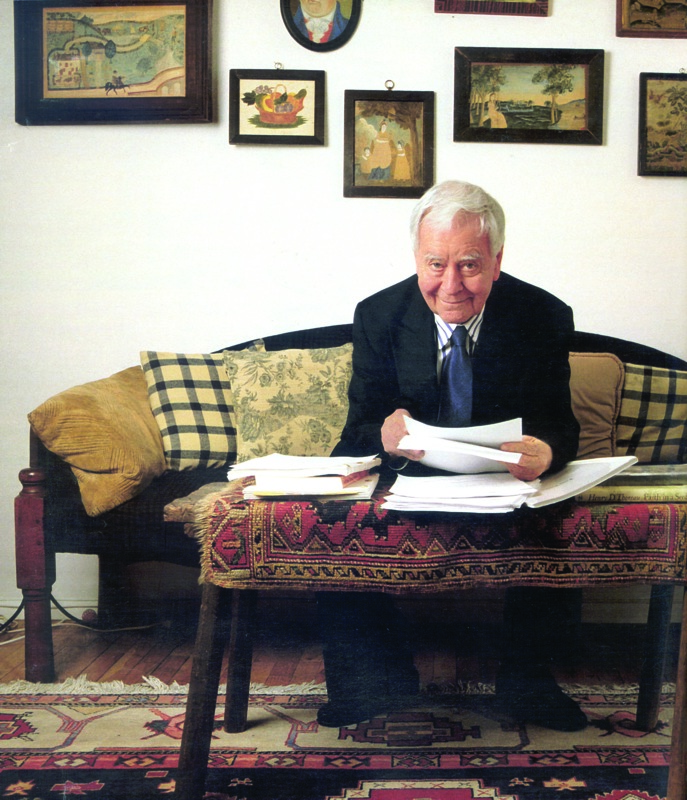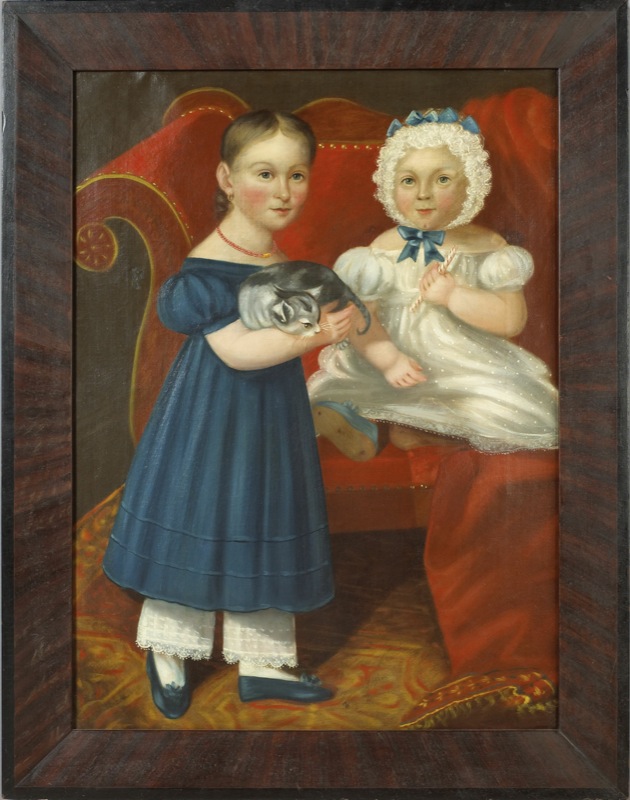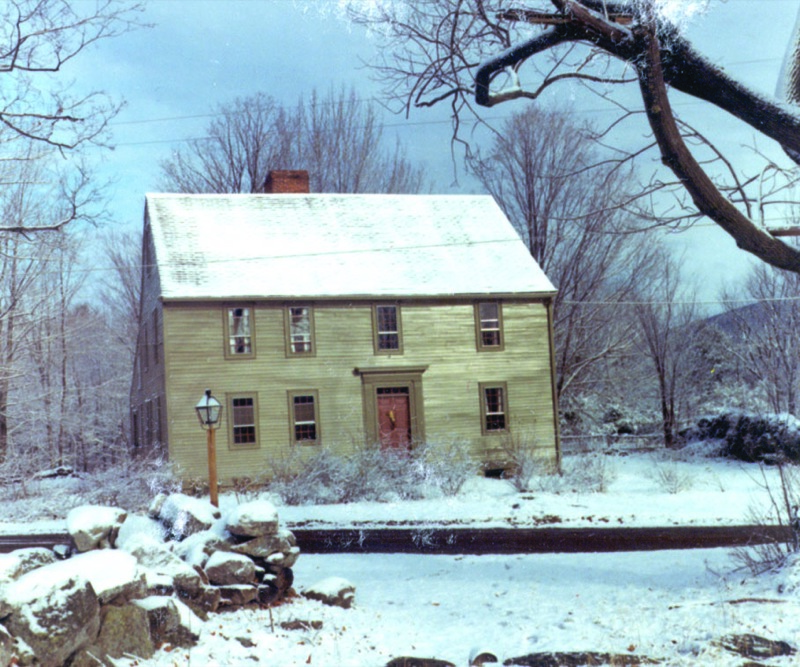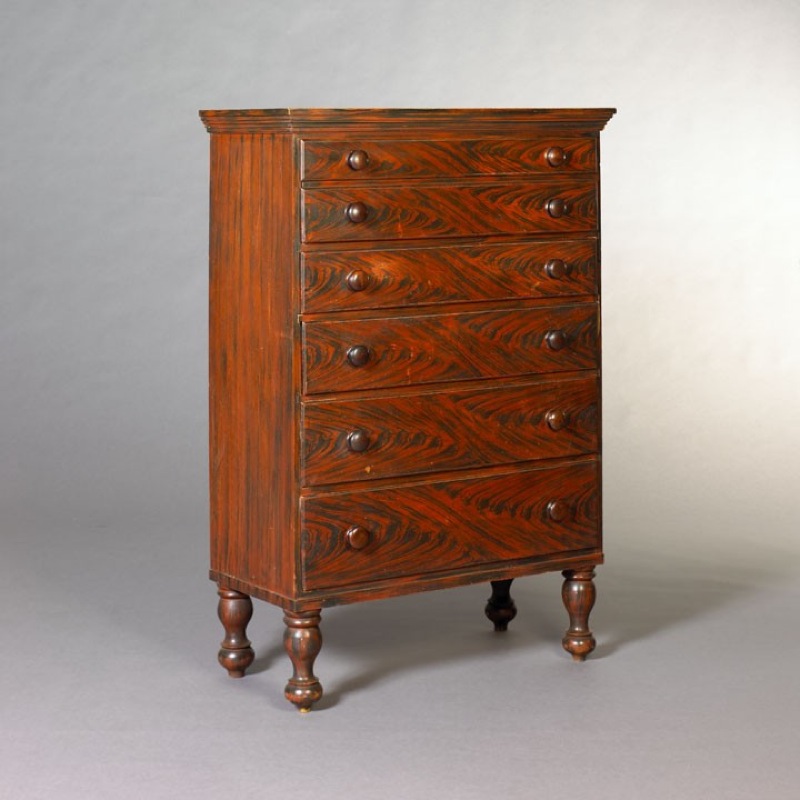
Horton Foote, a Pulitzer Prize winning American playwright (“The Trip to Bountiful,” “The Young Man from Atlanta”) and a screenwriter (“Tender Mercies,” “To Kill a Mockingbird”) with more than one Academy Award, died yesterday at the age of 92. In his work and in his life Foote spoke eloquently for the traditional American values of the small Texas town where he was raised. Not surprisingly Foote was also an avid antiques collector. In the catalogue for the sale of his collection at Northeast Auctions in 2005, Foote and his daughter Daisy, also a playwright, wrote about the place of antiques in their family’s life:
Horton Foote:
My wife and I became interested in antiques out of necessity. We were living in Nyack, New York at the time and had just bought our first house, leaving us little to spend on furnishings. Our visits to stores in the area were discouraging as anything that we liked we couldn’t afford. On one of our trips, we passed a small, white frame building on Highway 9W in Nyack with a sign saying “Antiques” and we decided to stop and go in. The shop was owned by Nina Claire, and Italian American who had been raised in New York City, and we learned later had a great love for American antiques. She greeted us warmly, explaining that what she had for sale at present were cottage antiques, but if we were interested in collecting they were a good place to start. There were four small chests that my wife thought attractive and useful and I spotted a small rug that I liked and when we found she was asking much less than the furniture stores, we continued looking, and that afternoon we filled the back of our station wagon with the small rug, some chairs, a cupboard and two of the small chests.

We began visiting Nina’s shop at least once a week and one time when I went over alone, I saw a painting of a young child, which I liked, and she said she was asking twenty-five dollars for it, but since we had bought so much furniture earlier, she would sell it to me for fifteen dollars. She showed me two other paintings, a portrait of a woman, and a landscape of Sparkill, New York. I bought the portrait of the child, and the next day I came back and bough the portrait of the woman, and for my birthday my wife bought the landscape as a present for me. Thus began our life as collectors and it was a wonderful time to begin. Lillian Cogan and Florene Maine were alive then and always had booths in the prestigious New York Winter Antiques Show. We were attracted to their booths, particularly Lillian Cogan’s, filled with what we were told were early American antiques, some even Pilgrim Century. Both ladies were patient and kind no matter how many questions my wife and I asked.
From the beginning, my great and abiding interest was in paintings. Whenever I went into a shop, or the home of a dealer, the first thing I looked for were his paintings. Why they interested me so much is still a mystery to me, for I was born and raised in a small Texas town far away from New England, but interested I was. The portraits particularly intrigued and moved me, and I never tired of looking at the ones we owned, wondering about their lives and at the different painting styles of the signed paintings and wondering, too, about the unsigned ones. Who could have painted them? Man or woman? And for what purpose?
Once, early on in New Hampshire, I came across five unsigned paintings that I knew enough by then were unmistakably by Prior. I took them home elated, but I didn’t keep them very long. I sold them to help pay for my children’s college education.
It has been forty or more years since we began collecting paintings. I live again in Texas where the walls of our house were filled with the paintings. Paintings of landscapes that had never been seen in Texas, and portraits of men and women wearing clothes never seen in Texas, but they had all become friends and I will miss them.

Daisy Foote:
In the mid 1960s, my parents moved their family from the suburbs of New York to the relative “wilds” of New Hampshire. They had been searching for houses for several years; answering countless ads for “pure” 18th century homes in New York, Massachusetts, and even Maine. But again and again they were disappointed as homeowners proudly showed off their improvements. So when my mother showed my father an ad in Yankee Magazine touting an untouched 18th century salt box in the town of New Boston, New Hampshire, he was having none of it. But she had a feeling about this one. And after a bit of cajoling and because my father really did believe that the house was out there somewhere, he agreed to drive the five hours north. And I went with them. That day my parents found their home. Only two families had owned it before them. First the Chanceys, then the Campbells and now the Footes. It was a glorious house complete with numerous fireplaces including the wide deep fireplace in the keeping room, wide textured floorboards, and an attic that would become my father’s study.
Now that the house was bought, the next question would be—how to fill it? My parents had been collectors of more formal antiques, a mixture of American mid-19th century and English pieces. A wonderful collection but not right for their New England home. The search for the right pieces would bring them in contact with a man who would influence their collecting and tastes for the next twenty years and beyond. His name was Roger Bacon.
I was trying to remember exactly how my parents met Roger, his wife Ruth, and subsequently his brother Reggie. I called Dad and he couldn’t remember the exact details, but he does remember the very first thing he and my mother bought from Roger, a table. Roger said to them, “If you like that, you’ve got good taste.” I also remember that it was Roger and Reggie that helped my parents find a restoration expert for their house. There was a fire soon after they moved in, and the keeping room was badly damaged. Roger and Reggie sent them to a man in Deerfield, Massachusetts. As always, their advice was right. The restoration was exactly and beautifully done.
It wasn’t long before my parents were driving over to Roger and Ruth’s home in Exeter every weekend. I loved those Saturday nights with the Bacons. Their late 19th century house and fireplace that you could actually sit in while the fire was burning endlessly fascinated me. And listening to Roger talk about each and every piece of furniture, painting and decorative object in that house was like listening to a master storyteller. I can still hear his voice as he showed my parents a gate leg table, candleholder or a hatbox. The reverence in his voice was always the same. “Jesus Christ,” he would say, “Jesus Christ. Have you ever seen anything so beautiful? Have you ever seen anything so beautiful? My God. My God…look at that. Look at that.” His energy was real and it was contagious.

It was a curious time for my parents. They had been part of a fast-paced competitive life in New York. But my father and my mother knew that it was right to retreat from all of that. My dad desperately wanted to hold onto his own particular artistic voice, to maintain his integrity, his unique style. How interesting that the move brought them to a man like Roger whose love of antiques was always rooted in integrity and character.
My parents became avid collectors and soon they were discovering other dealers, attending auctions and shows. I particularly remember the summer auctions. The station wagons and trucks pulling into large fields or onto the lawns of houses. People enjoying picnics and friendly banter before the main event. Really, it was as much about greeting old friends and exchanging stories as it was about the actual auction. And I now remember that when my parents did purchase something, Roger and Ruth would travel over to our house to see it. And Roger would be as enthusiastic as ever. It didn’t matter that my parents hadn’t bought it from him. He treated every piece of furniture or the painting like a lost old friend as he lovingly described details of color and form that no one else could see.
You can’t talk about Roger without mentioning Reggie. They were brothers, their connection deep and vivid. Yet they were different. Both had been actors, performers of everything from vaudeville to Shakespeare. But while Roger had a passion for objects, Reggie had a passion for buildings. My mother had a special affinity for Reggie as she had a love and a gift for design. Reggie helped her to find a barn that would become the home of my horse and pony. But more importantly it was the right barn. Roger’s son and a crew would move it in pieces to our house. I can remember Reggie over at our house pointing out details of the still to be assembled barn to my mother, and like his brother, he had an understanding, a feeling for the detail that comes only with being a master.
Roger continued to care for my parents even after he stopped selling. He directed them to another master, Pam Boynton. He so admired Pam and assured my parents that she would take good care of them. She has done this and is still doing this for my father. I guess what sets people like Pam, Roger and Reggie apart is their love of the pieces. They treat them like old and treasured friends.
I can still remember those winter evenings as I sat inside the fireplace listening to Roger and Ruth talk about an antique they had just bought or something they had seen and admired. My mother is gone now, as are Roger, Ruth and Reggie. But if I close my eyes and listen, I can hear Roger’s booming voice, the infectious enthusiasm, “Can you believe it?” he’d say, “Have you ever seen anything so beautiful?” And he meant it; every single word.
All images and text courtesy of Northeast Auctions.
